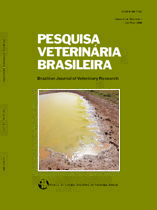 |
|
|
|
Year 2014 - Volume 34, Number 5
|

|
Diarrhea outbreaks in suckling piglets due to rotavirus group C single and mixed (rotavirus groups A and B) infections, 34(5):391-397
|
ABSTRACT.- Lorenzetti E., Stipp D.T., Possatti F., Campanha J.E.T., Alfieri A.F. & Alfieri A.A. 2014. Diarrhea outbreaks in suckling piglets due to rotavirus group C single and mixed (rotavirus groups A and B) infections. Pesquisa Veterinária Brasileira 34(5):391-397. Laboratory of Animal Virology, Department of Veterinary Preventive Medicine, Universidade Estadual de Londrina, Rodovia Celso Garcia Cid, Campus Universitário, Cx. Postal 10011, Londrina, PR 86057-970, Brazil. E-mail: alfieri@uel.br
Porcine group A rotavirus (PoRVA) is a major cause of neonatal diarrhea in suckling and recently weaned piglets worldwide. The involvement of non-group A rotavirus in cases of neonatal diarrhea in piglets are sporadic. In Brazil there are no reports of the porcine rotavirus group C (PoRVC) as etiologic agent of the diarrhea outbreaks in piglets. The aim of this study was to describe the identification of rotavirus group C in single and in mixed infection with rotavirus groups A and B in three neonatal diarrhea outbreaks in suckling (≤21-day-old) piglets, with 70% to 80% and 20% to 25% of morbidity and lethality rates, respectively, in three pig herds located in the state of Santa Catarina, Brazil. The diagnosis of PoRV in the diarrheic fecal samples was performed using polyacrylamide gel electrophoresis (PAGE) to identify the presence of porcine rotavirus groups A, B (PoRVB), and C, and by RT-PCR (PoRVA and PoRVC) and semi-nested (SN)-PCR (PoRVB) to partially amplify the VP4 (VP8*)-VP7, NSP2, and VP6 genes of PoRVA, PoRVB, and PoRVC, respectively. One RT-PCR (PoRVA and PoRVC) and SN-PCR (PoRVB) product of each group of rotavirus of each diarrhea outbreak was submitted to nucleotide (nt) sequence analysis. Based on the PAGE technique, 4 (25%) and 1 (6.25%) of the 16 diarrheic fecal samples evaluated in the first outbreak presented PoRVA and PoRVC electropherotype, respectively, and 11 (68.75%) were negative. In the second outbreak, 3 (42.85%) of the 7 fecal samples evaluated presented PoRVA electropherotype, and in 3 (42.85%) and in 1 (14.3%) fecal samples were detected inconclusive and negative results, respectively. Three (30%) of the 10 fecal samples of the third outbreak presented PoRVC electropherotype; 5 (50%) and 2 (20%) samples showed negative and inconclusive results, respectively. Based on the RT-PCR and SN-PCR assays in the first neonatal diarrhea outbreak, PoRVC was detected in 13 (81.2%) of the 16 diarrheic fecal samples evaluated. PoRVC single infection was identified in 4 (25%) of these samples and mixed infections with PoRVA and PoRVB in 9 (56.2%) fecal samples. All of the seven diarrheic fecal samples evaluated from the second neonatal diarrhea outbreak were positive for PoRVC, whereas its mixed infection with other PoRV groups was detected in 4 (57.2%) samples. In the third outbreak, PoRVC in single infection was detected in all of the 10 diarrheic fecal samples analyzed. In the nt sequence analysis, the PoRVA strains of the first and second outbreaks demonstrated higher nt identity with G4P[6] and G9P[23] genotypes, respectively. The PoRVB strains (first and second outbreaks) and the PoRVC strains (first, second, and third outbreaks) showed higher nt identity and clustered in the phylogenetic tree with PoRVB and PoRVC strains that belong to the N4 and I1 genotypes, respectively. This is the first description in Brazil of the involvement of PoRVC in the etiology of diarrhea outbreaks in suckling piglets. The results of this study demonstrated that PoRVC, in both single and mixed infections, is an important enteropathogen involved in neonatal diarrhea outbreaks in piglets and that the use of more sensitive diagnostic techniques allows the identification of mixed infections involving two or even three groups of PoRV, which may be more common than previously reported. |
| |
|
|
| |
|
 |